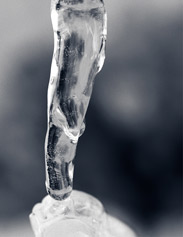

Wednesday - April 18, 2007
SLAC Today is
available online at:
http://today.slac.stanford.edu
In this issue:
Atoms Fly Apart in Direct Crystal Melting
Profile: Janice Dabney: Career Development Advocate
LCLS Progress Reaches a New Pitch
 |
 |
|
Wednesday - April 18, 2007 |
Atoms Fly Apart in Direct Crystal Melting
Photo courtesy of CONTAX images.
Using an intense laser and ultra-fast x-rays, Stanford Synchrotron Radiation Laboratory (SSRL) researchers have observed the atomic events involved in rapid crystal melting. Ordinary thermal melting determines the fate of an ice cube in a cup of tea or an icicle out in the blazing sun. The slow-acting heat causes atomic nuclei within the ice to vibrate destructively, disrupting the chemical interactions between the atoms. This allows the ice to relax its shape from an ordered crystal to a disordered liquid. At the Sub-Picosecond Pulse Source (SPPS), scientists used an alternative route to crystal melting that enabled them to make a "movie" of the atomic motions that lead to crystal disordering. The international collaboration used an ultra-fast, high-energy laser to rapidly heat the electrons in a crystal without heating the atomic nuclei; the laser warmed the outer electrons while leaving the heavy core of the atom cold. In this "electronically driven melting," the electrons gained energy and flew out of their regular orbit around the core, instantly breaking the chemical bonds they had shared with electrons from neighboring atoms. Short bursts of x-rays provided by the SPPS measured the atomic positions of the atoms in a semiconductor material. The data, published recently in Physical Review Letters, revealed that when their bonds destabilized, the atoms moved apart from each other quickly, as if repelling each other. The semiconductor material had visible melting damage after being struck by the laser. "This research provides verification that intense ultra-fast x-ray sources like the upcoming Linac Coherent Light Source (LCLS) will make possible the study of previously inaccessible material properties," said SSRL researcher Patrick Hillyard. |
||
|
|
||
 Janice Dabney: Career Development Advocate
Dabney recalled her discussion about career development at last month's Women's Interchange at SLAC seminar, where she joined co-presenters Laurie Escudero and Roz Pennacchi. "I'm always trying to learn new things," she said. "When I first came to SLAC, I never imagined there'd be so many opportunities for growth." She began as a secretary in the Klystron Department and rose through the ranks of various administrative and safety positions. Still, Dabney wasn't always self-assured in the workplace. "When I came to SLAC, I wasn't fully confident in my abilities," she said. "But when competence is rewarded with promotions, confidence comes too. It's sort of a circle." Now she encourages employees looking to boost their own careers. A few of her tips for advancement: take risks; keep a positive attitude; be a sponge for new knowledge and skills. Help others succeed. Most importantly, learn to communicate effectively. For more career advice, view Dabney's WIS lecture slides. |
LCLS Progress Reaches a New Pitch
It's not hard to tell that progress on the Linac Coherent Light Source (LCLS) is gaining momentum. In addition to the First Electrons milestone earlier this month, conventional facilities construction across the lab continues to gather steam. Crews are busily erecting wall forms and pouring the concrete floor of the Beam Transport Hall (BTH), visible from the webcam at End Station B. When completed, the BTH will span the research yard between the end of the linac and the Undulator Hall. Excavation for the Undulator Hall tunnel leading out of the Research Yard has also commenced, with the second roadheader now busily chewing its way toward the Beam Dump. The Near Experimental Hall continues to take shape, and last week saw the completion of the deck forming the second floor. The access tunnel leading out from behind the Collider Hall also passed 100 feet over the last few days. Check out the latest construction progress using the LCLS Dashboard, updated monthly. |
Events (see all | submit)
Access (see all)
Announcements
|
| | ||
|
|
||
 <%
Response.AddHeader "Last-modified", getArticleDate()
'Response.AddHeader "Last-modified","Mon, 01 Sep 1997 01:03:33 GMT"
'Monday, December 06, 2010
%>
<%
Response.AddHeader "Last-modified", getArticleDate()
'Response.AddHeader "Last-modified","Mon, 01 Sep 1997 01:03:33 GMT"
'Monday, December 06, 2010
%>View online at http://today.slac.stanford.edu/. |
||